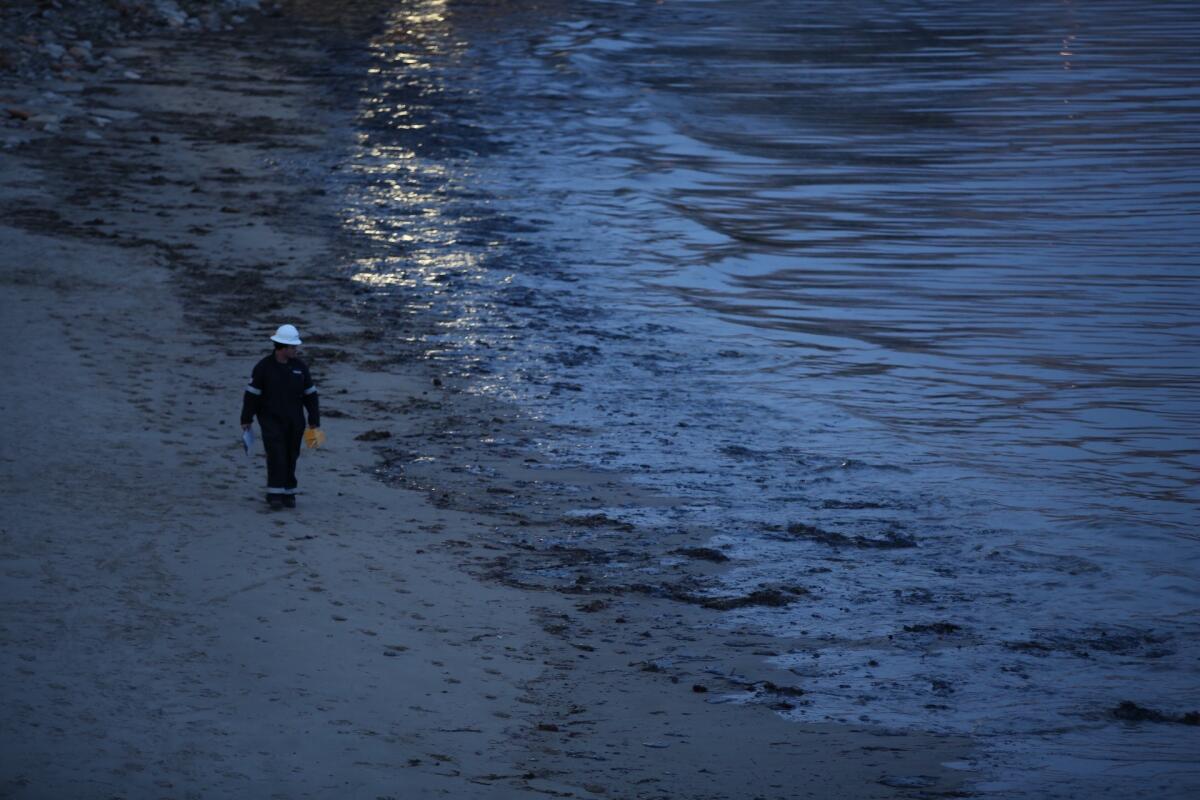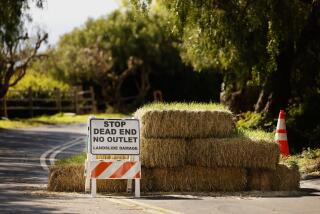Pipeline firm documents reveal chaos after Santa Barbara County spill

Authorities inspect the oily shoreline at Refugio State Beach.
Chaos and delay marked the initial hours after a pipeline burst last month along the Santa Barbara County coast, sending thousands of gallons of oil into the Pacific Ocean.
A timeline that Plains All American Pipeline provided to lawmakers was released Wednesday and details the company’s struggle to report the spill to federal regulators in the hours after the leak was identified.
Lawmakers wanted to know why the company did not alert federal regulators to the leak until nearly 3 p.m. May 19 despite the fact that operators in Midland had shut down the line at 11:30 a.m.
According to the company timeline, workers on the ground near Refugio State Beach didn’t know about the leak until they received reports of oil in the water from state parks staff around noon. Initially, company employees struggled to spot oil leaking from the underground pipeline.
Around 1:30 p.m., they realized oil was reaching the ocean via a storm culvert near where a corroded pipe had broken.
Meanwhile, company officials in Bakersfield who were responsible for alerting federal regulators were unable to contact employees on the ground near where Line 901 ruptured. In the letter to lawmakers, the company said workers in the field were “busy dealing with the immediate demands and distractions.”
Finally, at 2:56 p.m., federal regulators were notified. Even after alerting federal regulators to the spill, though, company employees in Bakersfield provided an inaccurate estimate of the volume of oil that had spilled.
The company initially estimated about 21,000 gallons were spilled and later revised the number to about five times that amount -- 101,000 gallons.
The timeline was included in a letter from Plains Chief Executive Greg Armstrong to Sens. Barbara Boxer (D-Calif.), Dianne Feinstein (D-Calif.), Edward J. Markey (D-Mass.) and Rep. Lois Capps (D-Santa Barbara).
“When accidents like this happen, speed is essential,” Boxer said in a statement to The Times. “It appears as though it took too long to detect and respond to this spill.”
In a separate letter to Capps, Armstrong said Line 901 and a larger pipeline that travels 128 miles from Santa Barbara to Kern County will remain shut off while federal regulators investigate both pipes.
The broken pipeline was extensively corroded, federal regulators have said.
The section of pipe that broke had worn down to 1/16 of an inch, and investigators found a six-inch crack along the bottom of the pipe, according to preliminary findings from the federal Pipeline and Hazardous Materials Safety Administration.
Line 903, the larger pipeline, also had corrosion problems, regulators said.
A pipeline company official and state and county oil spill response officials are set to appear Friday at a state oversight hearing held by State Sen. Hannah-Beth Jackson (D-Santa Barbara) and Assemblyman Das Williams (D-Santa Barbara).
The cost to clean up almost 100 miles of beaches after the crude oil spill has reached about $92 million, Patrick Hodgins, senior director of safety and security with the company, said during a news conference Wednesday.
Workers have cleaned approximately 93% of beaches damaged after the oil spill, but response officials said there is no timeline for cleaning the remaining eight miles of heavily oiled shore near Refugio State Beach.
The most difficult area to clean will be the sandstone cliff where crude from Line 901 first reached the ocean after traveling downhill from the broken pipe, said U.S. Coast Guard Capt. Jennifer Williams.
Thick black oil splashed onto the cliff face and large boulders nearby, leaving dark stains several feet high.
El Capitan State Beach will open to the public Friday morning for the first time since the spill, state parks officials announced last week.
In the letter, Plains officials did not provide a timeline for when Line 901 will begin operating again. Despite requests from lawmakers and others in the community, the company said it would not add an automatic shut-off valve to the pipeline. Company officials said that one is not required and that adding it would present other potential dangers.
Since the spill, 103 dead mammals and 192 dead birds have been collected, according to response officials.
Follow @jpanzar
More to Read
Sign up for Essential California
The most important California stories and recommendations in your inbox every morning.
You may occasionally receive promotional content from the Los Angeles Times.










